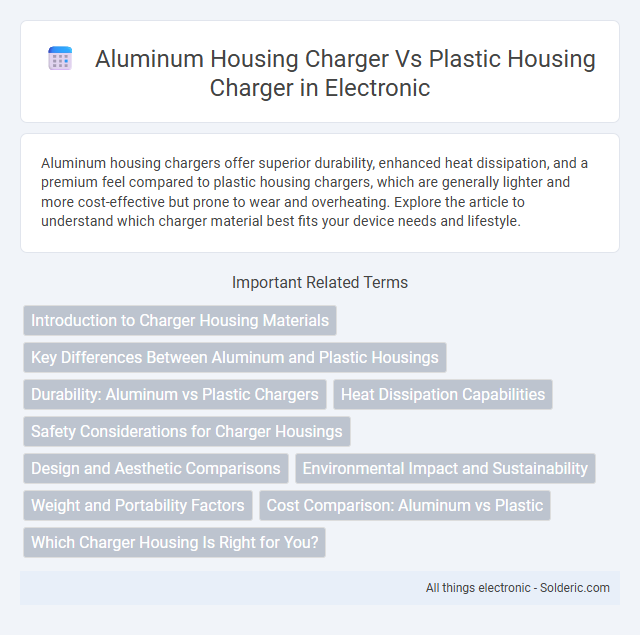Aluminum housing chargers offer superior durability, enhanced heat dissipation, and a premium feel compared to plastic housing chargers, which are generally lighter and more cost-effective but prone to wear and overheating. Explore the article to understand which charger material best fits your device needs and lifestyle.
Comparison Table
| Feature | Aluminum Housing Charger | Plastic Housing Charger |
|---|---|---|
| Durability | High resistance to impacts and scratches | Moderate, prone to cracks and wear |
| Heat Dissipation | Excellent thermal conductivity for cooling | Poor heat dissipation, risk of overheating |
| Weight | Heavier due to metal material | Lighter, easier to carry |
| Cost | Higher production cost, premium price | Lower production cost, more affordable |
| Aesthetic | Premium, sleek metallic finish | Variety of colors, less premium look |
| Environmental Impact | More recyclable and eco-friendly | Less recyclable, higher environmental footprint |
Introduction to Charger Housing Materials
Aluminum housing chargers offer superior durability, heat dissipation, and a premium feel compared to plastic housing chargers, which are typically lighter and more cost-effective but less robust. The thermal conductivity of aluminum helps prevent overheating during fast charging, enhancing device safety and longevity. Plastic housings, while offering greater design flexibility and lower manufacturing expenses, may degrade faster under intense use and provide less efficient heat management.
Key Differences Between Aluminum and Plastic Housings
Aluminum housing chargers offer superior heat dissipation and enhanced durability compared to plastic housing chargers, which are more prone to cracking and overheating. The metal construction of aluminum cases provides better electromagnetic interference shielding, ensuring stable performance and prolonged device lifespan. Your choice between aluminum and plastic housings directly impacts charger reliability, efficiency, and overall safety.
Durability: Aluminum vs Plastic Chargers
Aluminum housing chargers offer superior durability compared to plastic chargers due to their resistance to impact, heat, and wear over time. The metal construction of aluminum provides enhanced protection against drops and daily use, reducing the likelihood of cracks or deformation. In contrast, plastic chargers are more prone to damage from physical stress and environmental factors, leading to a shorter lifespan under similar conditions.
Heat Dissipation Capabilities
Aluminum housing chargers excel in heat dissipation due to metal's high thermal conductivity, effectively drawing heat away from internal components to prevent overheating. Plastic housing chargers, with their insulating properties, tend to retain heat, which can compromise performance and longevity during extended use. Choosing an aluminum charger can enhance your device's safety and efficiency by maintaining optimal operating temperatures.
Safety Considerations for Charger Housings
Aluminum housing chargers offer superior heat dissipation, reducing the risk of overheating and enhancing overall safety compared to plastic housing chargers, which tend to retain heat and increase fire hazards. The robust aluminum casing provides greater impact resistance and durability, protecting internal components from damage and minimizing electrical short circuits. Plastic housings, while lightweight and cost-effective, are more prone to cracking and melting under stress, posing potential safety risks in high-temperature or rough handling scenarios.
Design and Aesthetic Comparisons
Aluminum housing chargers provide a sleek, premium look with a matte or polished finish that enhances durability and resists scratches better than plastic. Plastic housing chargers often feature a wider range of colors and shapes but may appear less refined and are prone to yellowing or cracking over time. The metallic feel of aluminum housing contributes to a more modern and high-end aesthetic, appealing to users who prioritize stylish and robust device accessories.
Environmental Impact and Sustainability
Aluminum housing chargers offer superior environmental benefits compared to plastic housing chargers due to aluminum's high recyclability, with up to 95% of aluminum being recyclable without quality loss, reducing landfill waste significantly. The production of aluminum casings typically results in lower carbon emissions over the product lifecycle when combined with recycling practices, contrasting with plastic chargers that rely heavily on fossil fuels and often degrade into microplastics. Sustainable manufacturing preferences increasingly favor aluminum housing for chargers, supporting circular economy goals and minimizing ecological footprints in electronic accessories.
Weight and Portability Factors
Aluminum housing chargers offer a lightweight yet durable option, enhancing portability without compromising protection, often weighing less than plastic counterparts due to their efficient material structure. Plastic housing chargers, while sometimes heavier, can incorporate design elements that reduce overall bulk, but frequently lack the same strength-to-weight ratio as aluminum. Choosing aluminum housing improves ease of transport for frequent travelers and users prioritizing compact and robust charging solutions.
Cost Comparison: Aluminum vs Plastic
Aluminum housing chargers typically cost more than plastic housing chargers due to higher material and manufacturing expenses, but they offer superior durability and heat dissipation. Plastic chargers are generally more affordable, making them a popular choice for budget-conscious consumers seeking lightweight and versatile options. Your decision should weigh initial cost savings against long-term benefits like sturdiness and thermal management provided by aluminum.
Which Charger Housing Is Right for You?
Aluminum housing chargers offer superior durability, enhanced heat dissipation, and a premium feel compared to plastic housing chargers, which are lighter and typically more cost-effective. Your choice depends on whether you prioritize long-lasting build quality and efficient cooling or affordability and lightweight design. For heavy daily use, an aluminum charger housing ensures better protection and longevity, while plastic housing chargers suit occasional or budget-conscious users.
Aluminum housing charger vs plastic housing charger Infographic

 solderic.com
solderic.com